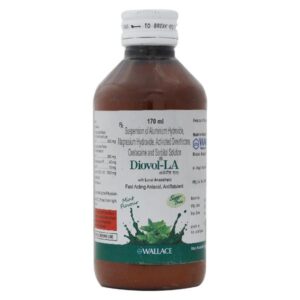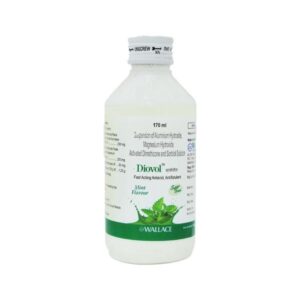DRIED AL(OH) + MG(OH)2 + ACTIVATED DIMETHICONE
Dried Al(oh): I’m sorry, but it seems that you’ve provided a drug name that does not exist. “Dried Al(oh)” does not correspond to any known medication. It’s possible that there might be a typographical error or misunderstanding in the name you provided. Please double-check the drug name and provide the correct information so that I can assist you accurately.
Mg(oh)2: Mg(OH)2, also known as magnesium hydroxide, is a medication primarily used as an antacid and laxative. It is commonly sold under the brand name Milk of Magnesia.
As an antacid, magnesium hydroxide works by neutralizing excess stomach acid, providing relief from heartburn, acid indigestion, and sour stomach. It also has mild laxative properties that help relieve constipation by drawing water into the intestines and promoting bowel movements.
The recommended doses for magnesium hydroxide vary depending on the intended use. For the relief of acid indigestion and heartburn, the average adult dose is 5-15 mL (1-3 teaspoons) orally, usually after meals and at bedtime, as needed. For constipation, the usual adult dose is 30-60 mL (2-4 tablespoons) orally once daily or in divided doses.
Common side effects of magnesium hydroxide include diarrhea, stomach cramps, and increased bowel movements. These effects are typically mild and go away on their own. However, if they persist or become severe, it is advisable to consult a healthcare professional.
In rare cases, magnesium hydroxide can cause more serious side effects such as dizziness, muscle weakness, slow or irregular heartbeat, and changes in mental/mood. If any of these occur, it is important to seek immediate medical attention.
It is always crucial to follow the recommended dosage and consult a healthcare professional or pharmacist before using magnesium hydroxide, especially if you have any underlying medical conditions or are taking other medications that may interact with it.
Activated Dimethicone: Activated Dimethicone, also known as Simethicone, is a drug that is used to relieve the symptoms of excess gas in the digestive system. It is available over-the-counter in various forms such as tablets, capsules, chewable tablets, and liquids.
The mechanism of action of Activated Dimethicone involves reducing surface tension and breaking down gas bubbles in the digestive tract, allowing them to be easily expelled through belching or passing gas. It does not affect the production of gas or prevent it from forming.
The recommended dose of Activated Dimethicone varies depending on the form of the medication. Typically, for adults and children over the age of 12, the usual dose is 40 to 125mg, taken as needed after meals and at bedtime. For children under 12 years old, the dosage should be determined by a healthcare professional.
Generally, Activated Dimethicone is well-tolerated and is considered safe for most people. It is a non-systemic medication, meaning it does not get absorbed into the bloodstream. Therefore, it has minimal risk of systemic side effects. Some common side effects that may occur include dizziness, headache, and diarrhea. However, these side effects are generally mild and temporary.
It is important to note that Activated Dimethicone should not be used as a treatment for underlying conditions that may cause excessive gas, such as lactose intolerance or irritable bowel syndrome. If symptoms persist or worsen, it is recommended to consult a healthcare professional for further evaluation and treatment. Additionally, individuals should read and follow the instructions on the product label and consult a pharmacist or healthcare professional if they have any questions or concerns regarding the use of Activated Dimethicone.


